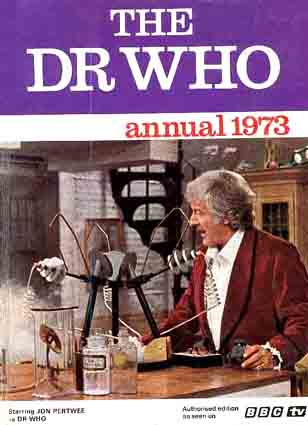The 1973 Annual

|
|
World Distributors The 1973 Annual |

|
| Published | 1972 |  |
| SBN | 7235 01793 |
| Starring the third Doctor, Jo Grant, UNIT and the Master |
A Review by Finn Clark 17/2/04
There wasn't an annual published for 1972, so two years elapsed between this and the last one. The result is a near-complete transformation. They hardly seem to be part of the same series, though close examination reveals more of those trademark World Distributors touches than you'd think.
The most obvious changes are cosmetic. Publishing technology had advanced since the sixties, allowing painted art for the internal illustrations as well as on the cover. As a result the Dr Who Annual 1973 looks glossier than its Hartnell and Troughton era predecessors, with the artists clearly more comfortable in full colour than in duotone and pen-and-ink. Not all of the pictures are painted of course, but even the pen-and-ink work somehow seems to look more professional. The Antarctic illustrations for War in the Abyss really add to the story's atmosphere.
Also important is the revamped format of the Pertwee era. With Earthbound stories and a cast of scientists, agents and UNIT soldiers, the Dr Who Annuals could no longer indulge in the fantastical to quite the same degree. Not one story from a Hartnell or Troughton annual was set primarily on contemporary Earth, unlike all of these. The result is a pulling-back from the kiddie-ness. Of course that skewed World-view still bleeds through even here, but it's as if the annuals have grown up. The quality level is higher and one gets the impression for the first time that a crap filter is in place.
Most importantly, the portrayals of the regulars are good. The annuals' Troughton-era regulars were abysmal, while Hartnell's Doctor was well-drawn but a solo traveller. However this is genuinely good. Pertwee's Doctor, Jo Grant, the Brigadier and the Master are all well written, with some nice character moments that put to shame a few Virgin and BBC novelists who've tried to capture the era. The lengthy Master-Doctor scene in Doorway into Nowhere fairly crackles. This makes such a difference! The story plots and concepts aren't far removed from what we'd seen before, but there's a sense of greater sophistication on display.
[However the book's shrunk. Instead of being a six-signature book of 96 pages (including endpapers), it's only a five-signature book of 80 pages. This makes it a significantly shorter read.]
But having said all that, this is still a Dr Who annual set in the World Distributors universe. The Dr Who annuals never really went in for bug-eyed monsters, going instead for the mind-bendingly surreal - and perhaps surprisingly that's more true than ever. In the entire book there's not one conventional rubber-suited alien. Instead we meet four forms of disembodied life, two machine species and a gateway to an unknowable universe in another dimension. There are shadowless bodysnatchers, alien mind-hoppers, invisible intangible diamond-collectors and a gigantic claw that can melt into mist. Deep underground live the Klatris, a race of subterranean robotic life that evolved from the regrouping of metallic molecules. Grounding all this in the real world of helicopters and the military just makes it seem less fantastical.
There's also a fair attempt at those World Distributors high-concept settings. In these seven stories, we go on the ocean, go potholing underground and see Antarctica and the Australian desert. The annuals' storytelling may have raised their bar a few notches for the Pertwee era, but they're still telling the same kind of tales that they always were.
Random observations:
(a) We meet Jo's uncle, though he doesn't seem like the string-pulling type. He's currently working on an oil rig in the Antarctic. Probably not the same uncle as the one at the UN, then.
(b) Hunt to the Death gives us a race of Charles Bronson clones from the planet Llios, chasing a metal monster called a Kelad. There's something about that name, if I could just put my finger on it... but no, it's nothing to do with the Daleks. However it's yet another Dr Who annual monster that's vulnerable to sound; in this case whistling.
(c) The bad guy in The Claw has a cool hideout.
Even the filler articles have changed. Instead of being straight-up space education, here we have offbeat features like the Seven Wonders of the World, a look at various national flags, creatures from Greek legend and some historical escapees including Charles II in 1651. For the first time since David Whitaker's collection in 1966, I found a Dr Who annual that could be read and enjoyed without irony and heightened camp awareness. It may not have a comic strip (damn!) but it's still pretty darned good.